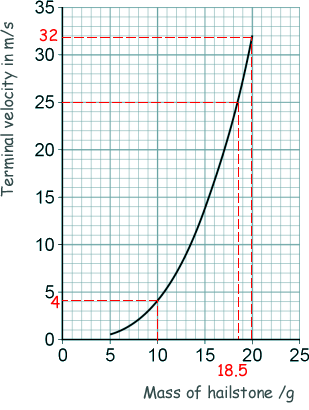GCSE Questions: Forces
Q32. Hailstones are small balls of ice.
Hailstones form in clouds and fall to the ground.
The photo shows different-sized hailstones.

(a) A hailstone falls from a cloud and accelerates.
(i) Why does the hailstone accelerate?
There is a net force downwards acting upon it - due to gravity - its weight. 
[1 mark]
(ii) The hailstone stops accelerating and reaches terminal velocity.
Explain why the hailstone reaches terminal velocity.
The weight of the hailstone is the driving force acting on the hailstone. As it accelerates the velocity of the hailstone increases.  This results in a counter force of air resistance acting upon it. This counter force increases as the speed of the hailstone increases,
This results in a counter force of air resistance acting upon it. This counter force increases as the speed of the hailstone increases,  until air resistance becomes equal to the weight of the hailstone. The resultant force is then equal to zero and the hailstone accelerates no more.
until air resistance becomes equal to the weight of the hailstone. The resultant force is then equal to zero and the hailstone accelerates no more.
[3 marks]
(b) The kinetic energy of a hailstone is measured in joules.
Which of the following is the same as 1 joule?
(c) A scientist investigated how the mass of hailstones affects their terminal velocity.
The graph below shows the results of her investigation.

(i) Tick one of the following to explain why terminal velocity increases with mass:
| As mass increases the cross-sectional surface area of a hailstone increases. |
|
| As mass increases the volume of a hailstone increases. |
|
| As mass increases the weight of a hailstone increases. |
 |
[1 mark]
(ii) Explain the difference in the maximum kinetic energy of a hailstone with a mass of
10 g and a hailstone with a mass of 20 g.
From the graph we can see that as the mass double from 10g to 20g the terminal velocity increases from 4 m/s to 32 m/s - an 8 fold increase.
Kinetic energy depends on both mass and velocity: 
EK = ½mv2
Now,
kinetic energy ∝ m 
therefore as mass increases so does terminal/maximum velocity by the same factor.
and
kinetic energy ∝ v2 
so if velocity doubles kinetic energy increases fourfold - but (from the graph) the 20g hailstone has 8 times the terminal velocity of the 10g one.
The 20g hailstone will therefore have 16 times the kinetic energy of a 10g one.
[3 marks]
(iii) A hailstone hit the ground at its terminal velocity of 25 m/s.
The hailstone took 0.060 s to stop moving.
Using information from graph above, determine the average force on the hailstone as it hits the ground.
m = 0.0185 kg 
u = 25 m/s
v = 0 m/s
t = 0.060 s
a = ?
v = u + at
0 = 25 + a x 0.060
a = - (25/0.060) 
a = - 417 m/s2
F = ma
F = 0.0185 x 417 = - 7.7 N 
[3 marks]
[12 Marks TOTAL]








